Rocky juniper "Munglow": description, planting and care
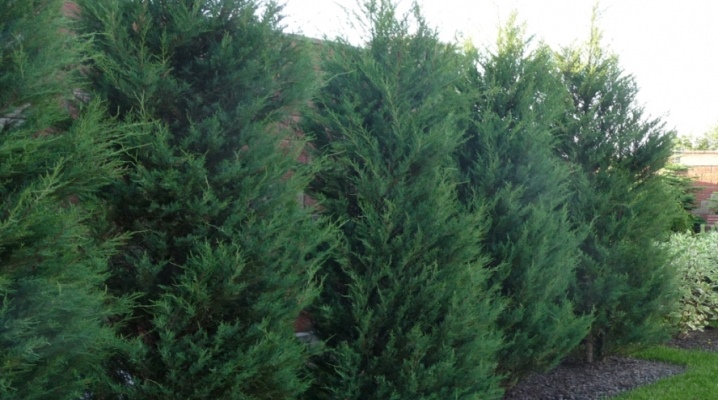
Moonglow Rock Juniper is very popular in garden landscaping. This is an ornamental plant of the cypress family with a bright blue pyramidal crown. The culture is ubiquitous in private and urban landscaping, with the most common juniper of this variety in the United States, southwestern Canada and northern Mexico.
Peculiarities
"Munglow" is a rocky juniper, which, according to the description, is capable of reaching 18 m in height and 2 m in diameter. However, the plant reaches such impressive dimensions only in its natural habitat, and in urban plantings its size is much more modest - the juniper is lower and thinner, but this does not in any way reduce the decorative effect of the variety. The crown of the conical type begins almost from the ground, but as it grows, it gradually begins to round. This year's shoots are deep bluish green or light blue in color. The length of the needles reaches 12 mm in length and 2 mm in width, after the flowering of the juniper, fruits are formed - their appearance resembles balls of dark blue color, reddish-brown seeds are formed inside the cones, growing up to 5 mm. The annual growth of Munglow is approximately 15–20 cm.
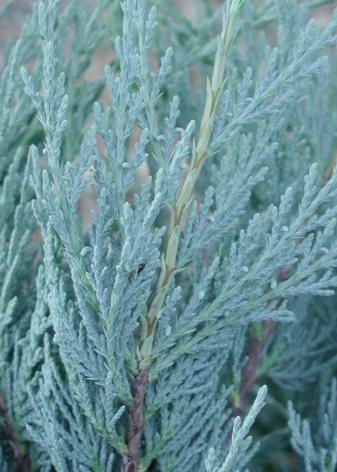
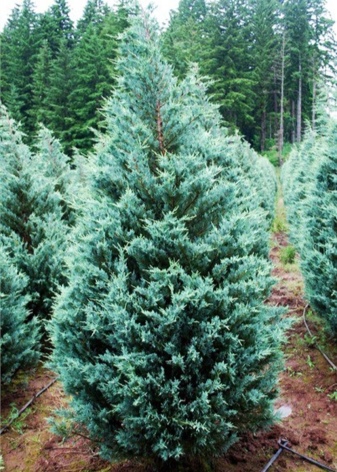
How to plant?
Rock juniper is usually planted in open ground with the onset of spring, it is best to take seedlings 3-4 years old for this. The plant must be strong: no signs of rot, damage by garden pests or other defects. Immediately before planting, all affected areas of the root system should be removed, and then the roots should be placed in a container with water, you can add Kornevin or any other growth stimulant to it. When choosing a seedling, be sure to pay attention to the container in which the juniper is grown.
Experienced gardeners note that those plants that grew in a container of 5 or more liters are distinguished by the best survival rate.
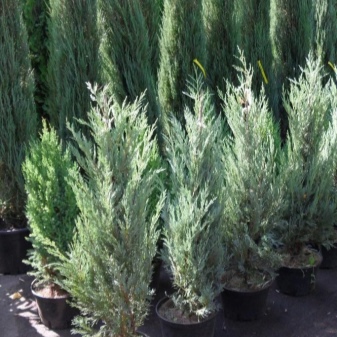
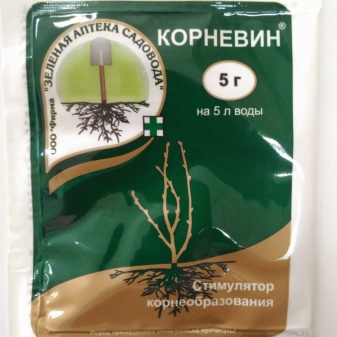
The place under the juniper should be well lit, but it is desirable that the light be diffused - direct ultraviolet rays often cause yellowing of the needles and their dropping. An important role is played by the level of occurrence of groundwater - they should not pass high, otherwise the substrate will be constantly waterlogged and the root system of the juniper will simply rot. High varieties must be planted in fertile soil, in all other cases it is better to give preference to dwarf varieties of "Munglou".
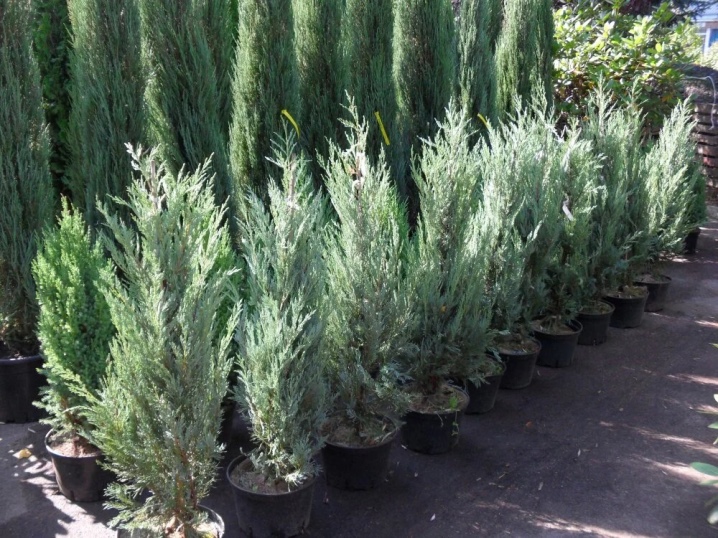
The Moonglow Juniper requires a nutritious, drained and loose soil with a high aeration capacity., therefore, the soil must be prepared a few weeks before planting - loosen, uproot all weeds, equip drainage grooves and prepare a planting pit 1 meter deep, the width should be 2-3 times the diameter of the earthen clod. Expanded clay, large pebbles or broken brick in half with sand should be poured at the bottom - a drainage layer is necessary so that moisture does not form, which has the most destructive effect on the plant. The hole is 2/3 filled with nutritious soil, consisting of sod land, river sand, as well as peat and humus. After the site is prepared, you can directly plant the ephedra.

Important! If you plan to plant several plants at once, then the distance between large varieties should be about 2 m, between dwarf ones - at least 0.5 m.
After planting, the land around the young bush should be watered abundantly and covered with a layer of mulch - most often sawdust, crushed coniferous bark or peat are used for this. Please note that if the seedling is sold with a closed root system, planting can be done at any time during the entire growing season.

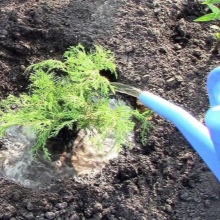
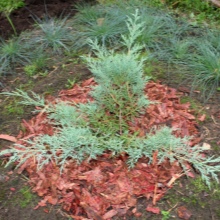
How to care?
Caring for "Munglaw" is not complicated at all - this plant is perfectly adapted to the city air with its high gas content. Munglow requires standardized care that involves several steps.
- Watering. It is not necessary to water the juniper often, it tolerates drought quite persistently, but excessive moisture should also be avoided, since abundant moisture causes the rapid death of plants. In general, two waterings per season will be sufficient. If the summer is hot and dry, the amount of irrigation can be increased. A young plant is watered in the evening with necessarily heated water, an adult tolerates cold moisture taken from a water tap, a well, a column and the nearest reservoir well.

- Conducting dressings. If the plant was planted in a nutritious soil, then in the first year after planting it will not need top dressing, and starting from the next season, fertilizers can be applied. In late April or early May, you can feed Moonglow with nitroammophos or kemira, in summer the plant responds well to potash and phosphorus fertilizers - they need to be applied after watering, while the earth is well moistened. Organic fertilizers are not recommended for juniper - they reduce the frost resistance of the plant, an adult ephedra does not need feeding.
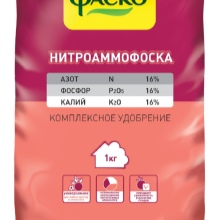

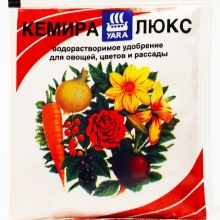
- Loosening and mulching. To retain moisture in the ground, to protect it from weeds, which take food from a young plant and slow down its growth, mulching is necessary, as well as loosening - it allows oxygen to be delivered to the roots.
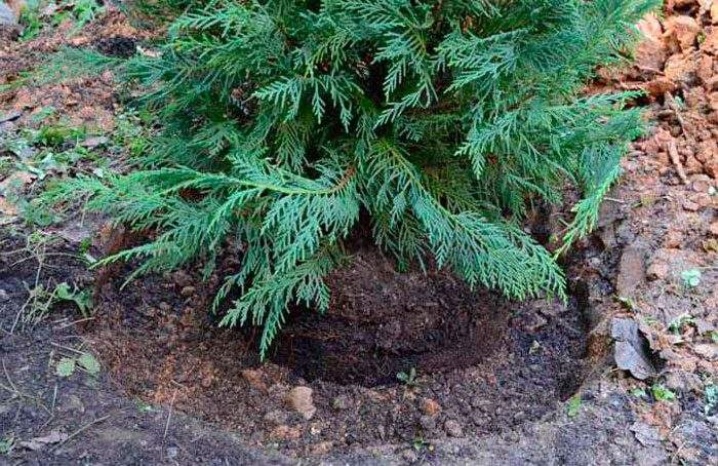
- Sanitary trimming and shaping. By nature, rocky juniper has a beautiful crown shape, so decorative pruning is not needed, but sanitary pruning should be carried out regularly. For the first time, damaged branches are removed in early spring before the start of sap flow. It is better to carry out all work in cloudy or rainy weather - with garden shears they cut off all dried branches infected with fungus and damaged by insects. And it will also be useful to get rid of improperly growing shoots in order to give the juniper an aesthetic appearance. For cutting, sterilized instruments are used, which will eliminate the risk of infection of the culture. After processing, the place is immediately coated with garden varnish, and the crown is sprayed with a copper-containing solution, for example, copper sulfate.
If you still want to transform the crown of your juniper, try to keep the pruning lightweight, the cuts should be no more than 2 cm, otherwise the juniper will experience severe stress and wither.
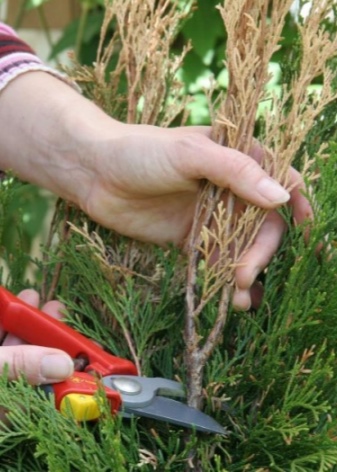
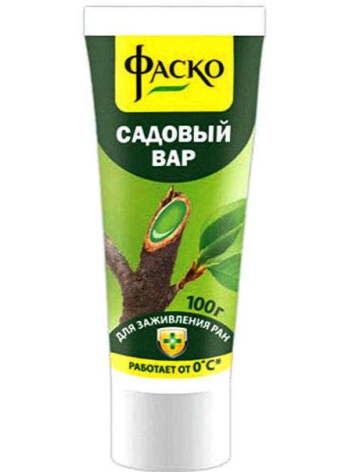
- Winter protection. Despite the fact that junipers are cold-resistant plants, they nevertheless need preparation for winter, or more precisely, from sunburn. The fact is that in winter or early spring, when the soil is frozen, the needles begin to burn from the bright sunlight. To avoid the plant losing its decorativeness, it must be covered with spruce branches or burlap linen at the end of autumn, while the branches are tightly tied with jute so that they do not break under the weight of snow. The shelter is removed only after the ground has completely thawed.
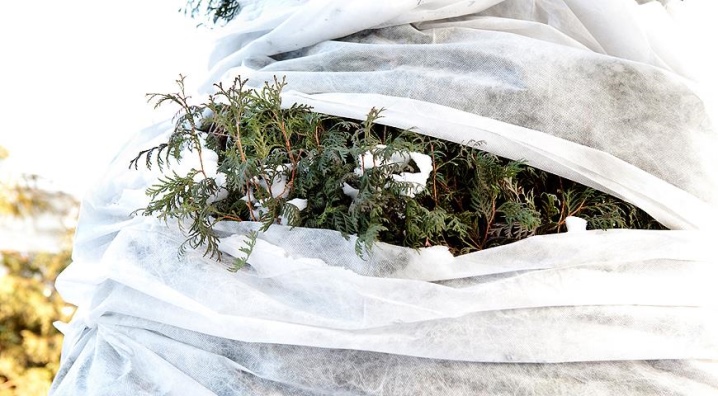
Reproduction methods
Moonglow is propagated in several ways.
Layers
To propagate a bush by layering, you should choose a healthy branch, free it from needles and fix the layering on the ground with hairpins.Six months later, root formation will begin, which lasts about a year - after strong roots have formed, the shoot can be cut off from the parent bush and transplanted to a permanent place.
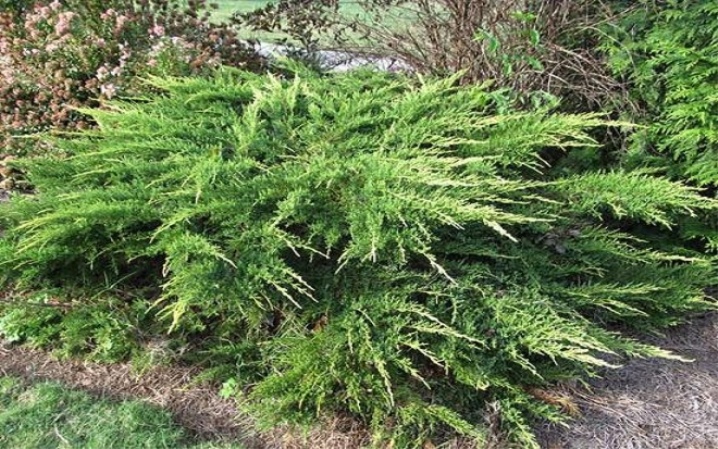
Cuttings
When using cuttings, it is better to harvest material for rooting with a vein. It is advisable to use the shoots of the current year, they should be semi-lignified and a small piece of wood and plant bark. Rooting is best done in the ground - the fact is that when you stay in water for more than 3 hours, the bark of the juniper begins to flake off, and the plant rots. Usually, the roots appear in 2.5 months, and after 3-4 the seedlings are ready to move into the open ground.
If you made the harvesting of cuttings later, planting material is planted in a permanent place only in the next season.
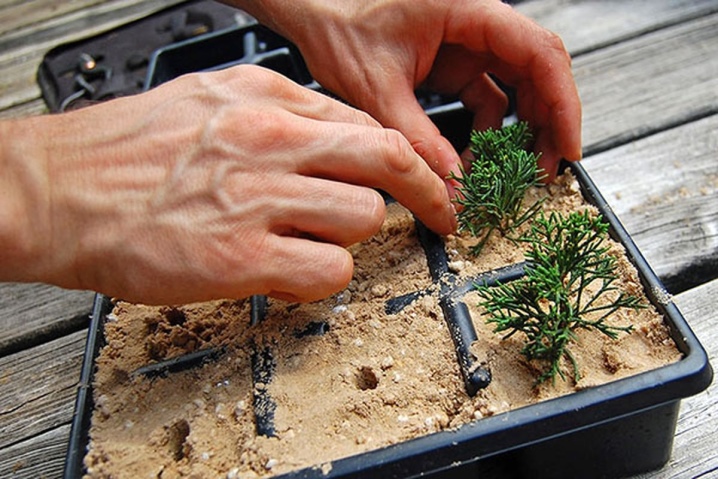
Diseases and pests
Unfortunately, many varieties of juniper are prone to fungal diseases, and they are also of interest to garden pests. Munglow is no exception. More often than not, junipers face several problems.
- Alternaria - a fungal infection, which manifests itself in the appearance of a whitish plaque on the needles. If you do not start the resuscitation of the plant in a timely manner, the needles will dry out quickly. The most common cause of this pathology is untimely sanitary pruning - this leads to the fact that the branches begin to grow too thickly. For the treatment of juniper, it is necessary to spray with Bordeaux liquid, it can also be used for preventive treatment in early spring.
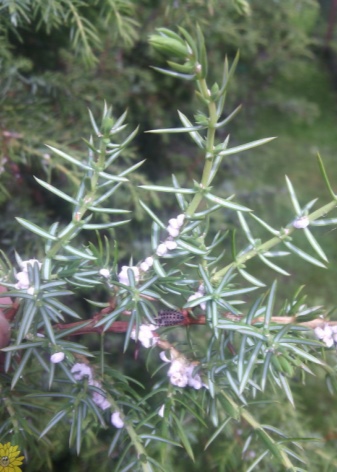

- Rust Is a fungal disease that begins with the appearance of rather large rusty growths on the branches. This infection poses a great danger to all the inhabitants of the garden, since the spores of the fungus are spread very quickly by the wind and in a fairly short period of time other shrubs and trees can become infected. Unfortunately, effective anti-rust preparations have not yet been created, so the only thing that can be done is to cut off the damaged branches and spray the remaining ones with fungicidal solutions.
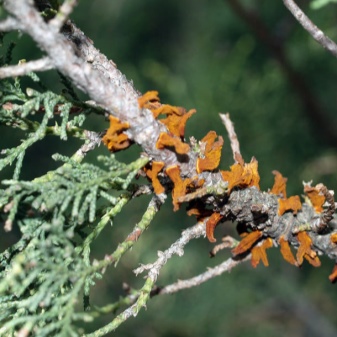
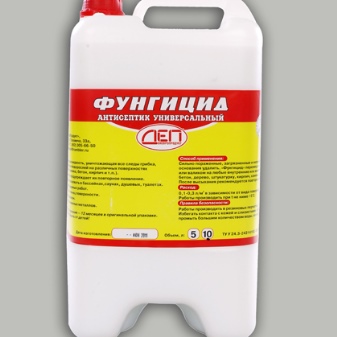
- Brown shute. The first sign of juniper damage is significant yellowing and shedding of the needles. The peak of development of the fungus occurs in June, and towards the end of summer, the needles begin to become covered with black dots. In the absence of quick measures to get rid of the misfortune, the disease rapidly spreads to neighboring plants, so you need to remove all damaged areas as soon as possible, collect and burn the fallen needles, and then spray the branches and soil in the near-stem circle with drugs such as "Strobi", "Skor" or Ridomil Gold.
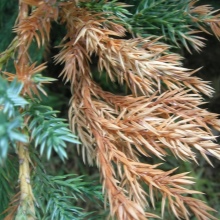
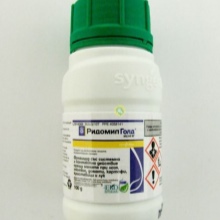

Juniper is often attacked by pests such as:
- gall midges - these are small insects no more than 2 mm in size; they actively lay eggs in the bark of the ephedra, which leads to its deformation;
- spider mite - can entangle juniper branches with cobwebs so that it significantly limits the access of light to the needles; insects parasitize the plant, sucking out all the juices from it, which can cause the death of the bush in a short time.
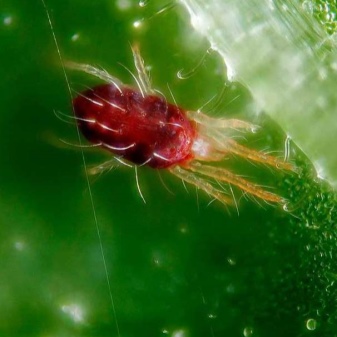
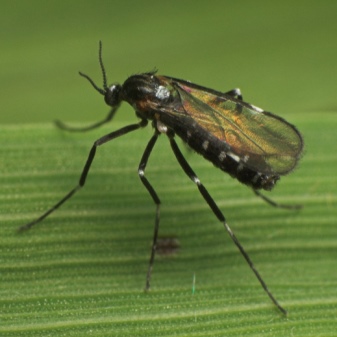
Use in landscape design
Moonglow juniper has a very spectacular appearance, therefore it is often used in landscape design.
- They are framed by alleys and gardens.
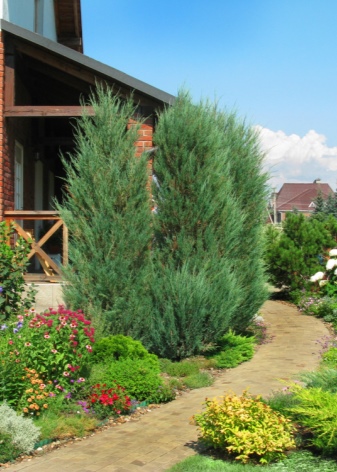
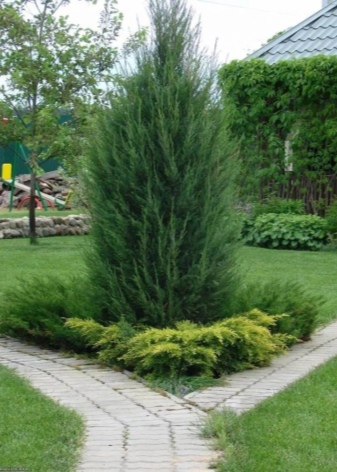
- "Munglaw" is in demand in rockeries, rock gardens and alpine slides.
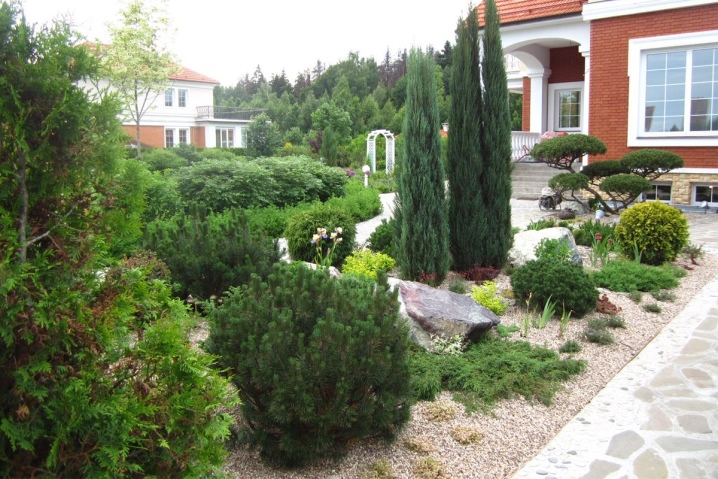
- It is ideal for creating a Japanese, Scandinavian or English garden on your backyard.
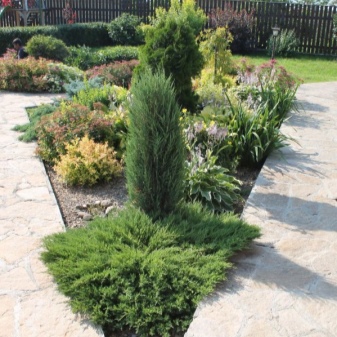
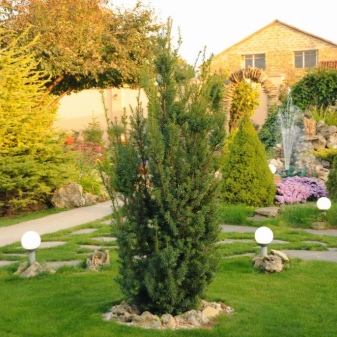
- Group plantings of this ephedra in city gardens and park areas look very impressive.
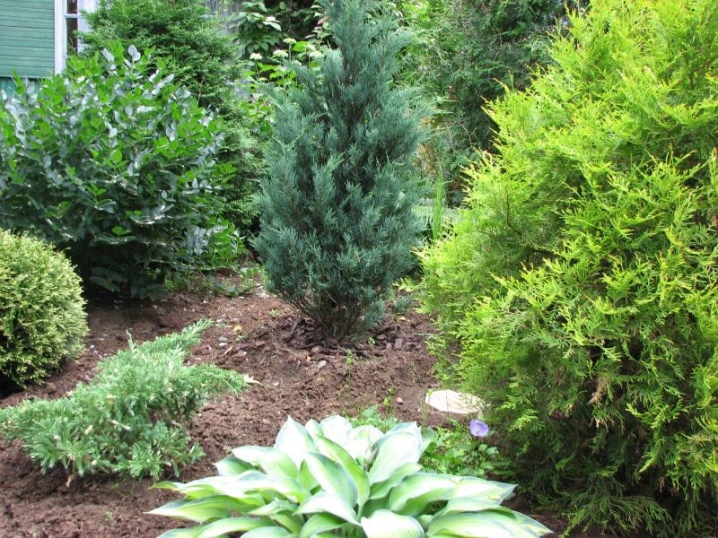
- "Munglaw" looks harmoniously in tandem with undersized conifers and ground cover plants.
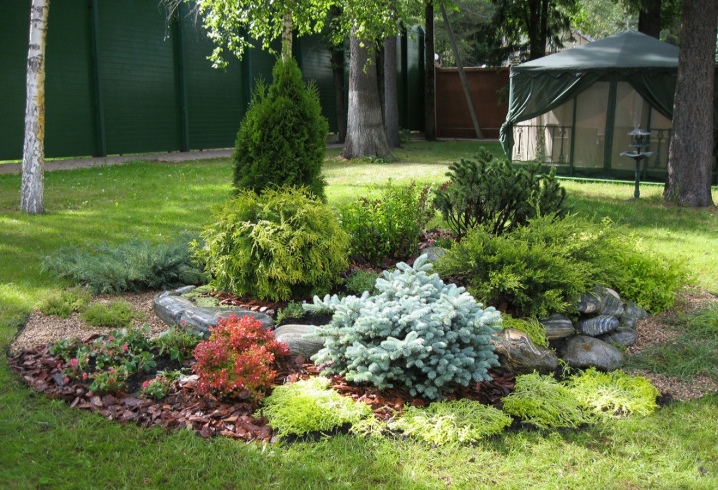
- This plant is used in floral arrangements, where it becomes the centerpiece in the frame of roses, hydrangeas and oak trees.
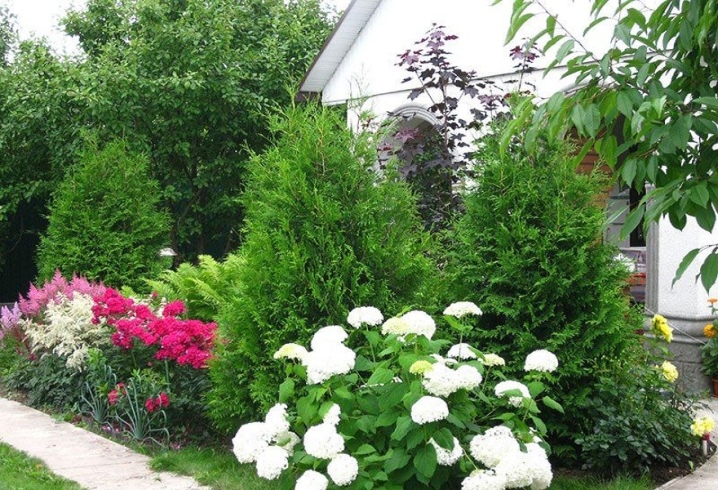
See the following video about caring for the rocky juniper "Munglaw".



































































The comment was sent successfully.